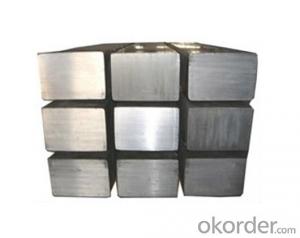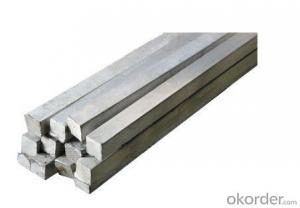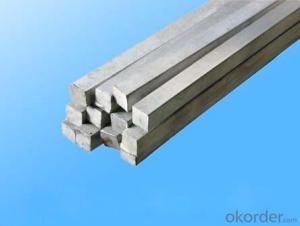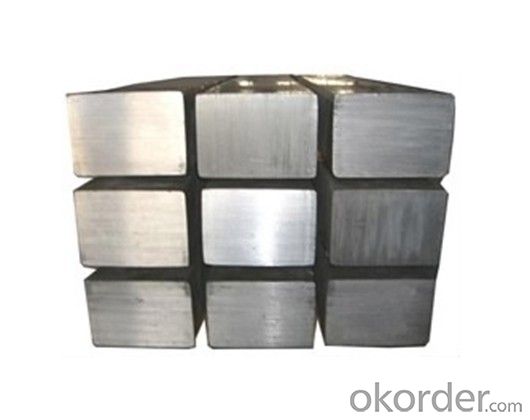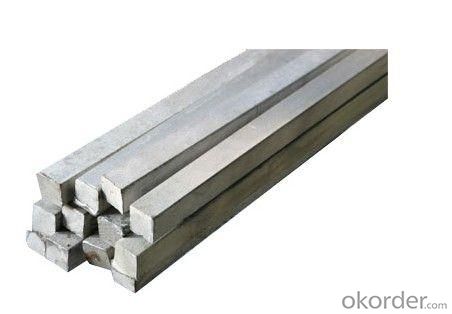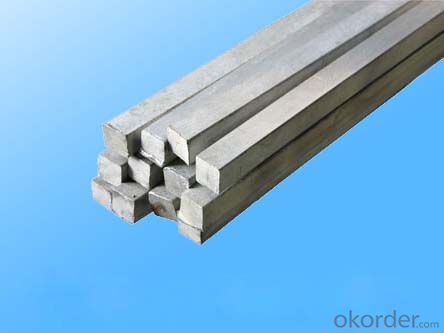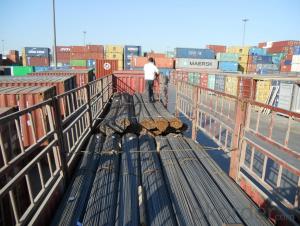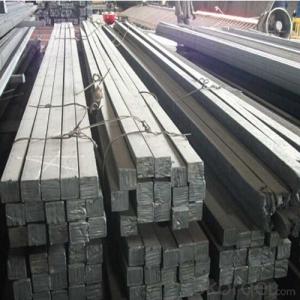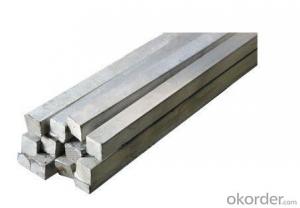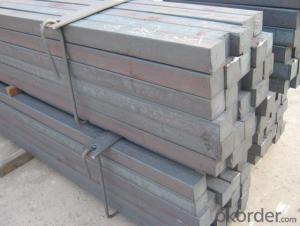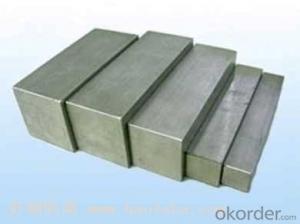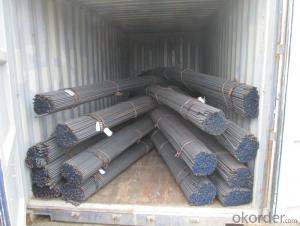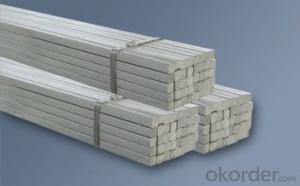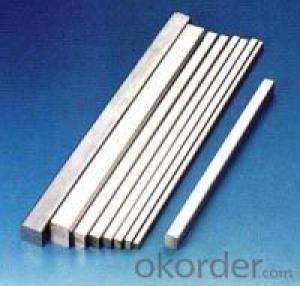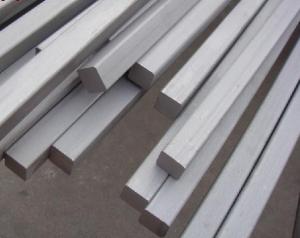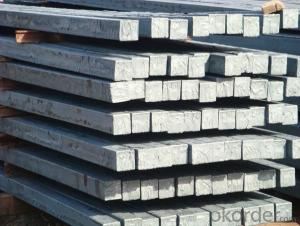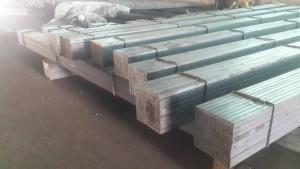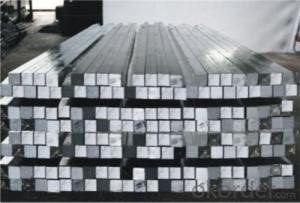Q195Cr High Quality Square Steel Bar
- Loading Port:
- Tianjin
- Payment Terms:
- TT OR LC
- Min Order Qty:
- 1000 m.t.
- Supply Capability:
- 100000 m.t./month
OKorder Service Pledge
OKorder Financial Service
You Might Also Like
Product Description:
Product Description:
In the production of steel products, steel is molded and reshaped with different machinery at different temperatures. One process is steel rolling, which involves metal stock passing through a pair of rolls. Rolling produces flat steel sheets of a specific thickness, and the process is classified according to the temperature at which the metal is rolled. If the temperature of the metal is above its recrystallization temperature, or the temperature at which the grain structure of the metal can be altered, then the process is termed as hot rolling. If the temperature of the metal is below its recrystallization temperature, the process is termed as cold rolling.
Like cold rolling, cold drawing is performed at room temperature, but instead of producing a flat object like a coke can, cold drawing makes steel into the form of a wire like the spokes of a wheel or a paper clip. To start the process, Steel is usual hammered and rolled so that it can be fit through a die; a tool that turns the steel mass into a wire. The room temperature steel is pulled through the die which reshapes it into a thinner shape while maintaining the same volume. It is similar to the idea of syrup flowing out of a bottle through a tube in that it changes shape but not volume, but instead of squeezing the metal, it is pulled out. In order to get the wire down to the right diameter, it usually requires more than one pass through different dies.
Colddrawn steel, steel covered carbon steel, excellent carbon steel, alloy structural steel, carbon tool steel, spring steel, bearing steel, tool steel, cold heading steel, free cutting steel, martensite stainless steel; products include all kinds of shapes round, square steel, hexagonal, flat steel and other conventional products, including various special-shaped steel products. In all types of colddrawn steel industry has been widely used, these areas include automotive, machine tools, furniture, standard parts, textile machinery, agricultural machinery, military industry and other industries.
The total assets of more than 40 million, as of the end of 2010 with fixed assets of 34 million, with 60 tons from 5 tons a chain drawing machine 10 sets, horizontal and inverted coiled wire drawing machine 5 sets, steel and plate production line of blasting, high-power ham stove, various straightening machine and cold rolling mill and other major equipment.
Usage/Applications
-The Square Bar is normally used as structure steel.
-Row material for other structure steel like steel angles, channels, I-beams, H-beams, etc…
Packaging & Delivery
-Packing Detail: The products can be packed in bundles by steel wires.
-Marks: We make tag marks and color marks. The tag marks with white background and red company logo will be tied up to each bundle of the products. The information is usually including basic information of products and company and other information requested by customers. As for color marks, we will paint both ends of bundles to make sure that it w
-Delivery Detail: 30~45 working days after receive buyer’s T.T. or L/C.
ill be more convenient for customers to distinguish them from other products.
- Q: Can a steel square be used for checking the squareness of cabinet doors?
- Yes, a steel square can be used for checking the squareness of cabinet doors.
- Q: How does a steel square assist in measuring and marking angles?
- A steel square assists in measuring and marking angles by providing a straight edge and a right angle that can be used as a reference. The square has a long blade that can be placed against a surface to measure its alignment, and a shorter tongue that can be used to mark right angles. By aligning the square's blade with a desired angle or using the right angle of the square to create perpendicular lines, accurate measurements and markings can be made.
- Q: Can a steel square be used for checking the squareness of a band saw table?
- The squareness of a band saw table can be checked using a steel square. This tool is commonly employed to verify the accuracy and squareness of different surfaces and angles. To assess the squareness of a band saw table, you must position the steel square against the table's edge and compare it to the band saw blade. If the blade perfectly aligns with the edge of the steel square, then the table is square. However, if there is any gap or misalignment between the blade and the square, then the table is not square and adjustments will be necessary. It is crucial to ensure the steel square's straightness and accuracy in order to obtain precise outcomes.
- Q: How do you use a steel square to determine the slope of a ramp?
- To determine the slope of a ramp using a steel square, you can place the square vertically against the ramp and align it with the surface. Then, using a level, ensure that the square is perfectly vertical. Next, measure the distance from the bottom of the square to the ramp surface at the point where the square is aligned. This measurement will give you the rise of the ramp. Finally, measure the distance from the bottom of the square to the point where the ramp ends. This measurement will give you the run of the ramp. Dividing the rise by the run and multiplying it by 100 will give you the slope of the ramp as a percentage.
- Q: Can a steel square be used for checking the flatness of a wall?
- No, a steel square cannot be used for checking the flatness of a wall. A steel square is primarily used in woodworking and metalworking for measuring right angles and making square cuts. It is not designed or suitable for determining the flatness or evenness of a surface such as a wall. To check the flatness of a wall, a straightedge or a level would be more appropriate tools to use. A straightedge can be placed against the wall to check for any deviations or irregularities, while a level can be used to ensure the wall is perfectly vertical or horizontal.
- Q: How do you use a steel square to measure the height of a cabinet?
- To use a steel square to measure the height of a cabinet, place the square vertically against the side of the cabinet, ensuring that it is flush with both the top and bottom edges. Then, read the measurement on the vertical side of the square where it aligns with the top of the cabinet. This will give you an accurate measurement of the cabinet's height.
- Q: What are the different ways to hold a steel square when making angle measurements?
- There are three main ways to hold a steel square when making angle measurements: 1) Holding it against the edge of the workpiece and using the inside corner as a reference point, 2) Placing it on top of the workpiece and aligning the blade with the desired angle, and 3) Holding it against the workpiece and using the outside corner as a reference point.
- Q: How do you maintain a steel square?
- To maintain a steel square, it is important to follow a few simple steps. Firstly, after each use, it is crucial to clean the steel square thoroughly to remove any dirt, dust, or debris that may have accumulated on its surface. This can be done using a soft cloth or brush, along with mild soap and water if necessary. Next, it is important to dry the steel square completely to prevent any moisture from causing rust or corrosion. After drying, it is recommended to apply a thin layer of lubricant or rust inhibitor to the steel square to protect it from moisture and to keep the surface smooth. This can be done by applying a small amount of oil or a specialized rust inhibitor and spreading it evenly across the entire surface of the square. Additionally, it is essential to store the steel square in a dry and clean environment to prevent any further exposure to moisture or contaminants. It is best to keep it in a dedicated case or storage box to protect it from accidental damage or scratches. Regular inspection is also necessary to identify any signs of wear or damage. If any issues are noticed, it is important to address them promptly to prevent further deterioration. This may include replacing any worn or damaged parts or seeking professional help if needed. By following these maintenance practices, a steel square can be kept in excellent condition, ensuring its accuracy and longevity for years to come.
- Q: How do you use a steel square for marking stair handrail height?
- To achieve the appropriate installation of a stair handrail, the following steps can be taken using a steel square: 1. Begin by measuring the distance from the stair tread to the top of the stair nosing. This measurement will determine the desired height for the handrail placement. 2. Position the steel square on the stair nosing, ensuring that the short side of the square rests on the nosing while the longer side extends vertically. 3. Verify the vertical alignment of the square by ensuring that the longer side is perfectly perpendicular to the tread surface. Accuracy can be ensured by utilizing a level or plumb bob. 4. Once the square is properly aligned, utilize a pencil or marker to mark the desired handrail height on the vertical edge of the square. This marking will indicate where the top of the handrail should be installed. 5. Repeat this process for each step of the staircase, guaranteeing consistent handrail height throughout. By employing a steel square in this manner, one can effectively mark the desired handrail height on each step, resulting in a uniform and secure installation.
- Q: How do you use a steel square to determine the angle of a compound fluting cut?
- In order to determine the angle of a compound fluting cut using a steel square, the following steps should be followed: 1. Begin by positioning the steel square on the workpiece, ensuring that its long side runs parallel to the edge of the material to be fluted. 2. Align one of the edges of the steel square with the material's edge, ensuring a secure hold. 3. Proceed to draw a line along the other edge of the steel square onto the material. This line will serve as a reference for the fluting cut angle. 4. Utilize a protractor or a bevel gauge to accurately measure the angle between the reference line and the desired direction of the fluting cut. 5. Once the angle has been determined, transfer it to your chosen cutting tool or machine. This can include a router, table saw, or any other appropriate tool capable of executing the fluting cut. 6. Adjust your cutting tool or machine to match the measured angle. This might involve modifying the table or fence on a table saw, or changing the angle of the router bit. 7. Before initiating the cut, double-check your setup to ensure the correct alignment of the tool or machine. 8. Finally, carefully guide the material through the cutting tool or machine, following the determined angle, to make the compound fluting cut. Always prioritize safety when working with cutting tools or machines. Adhere to the manufacturer's instructions and wear appropriate protective gear to prevent accidents and injuries.
Send your message to us
Q195Cr High Quality Square Steel Bar
- Loading Port:
- Tianjin
- Payment Terms:
- TT OR LC
- Min Order Qty:
- 1000 m.t.
- Supply Capability:
- 100000 m.t./month
OKorder Service Pledge
OKorder Financial Service
Similar products
Hot products
Hot Searches
Related keywords
